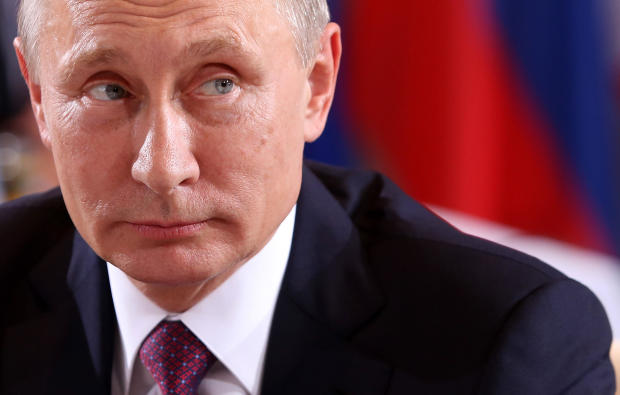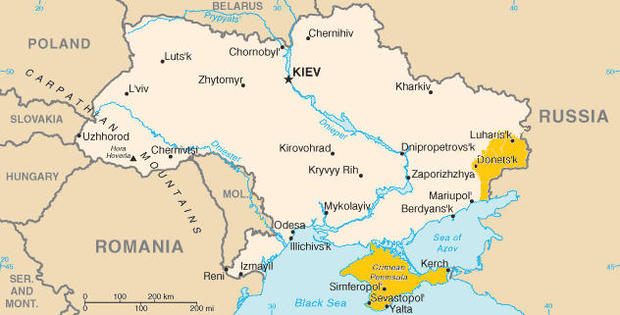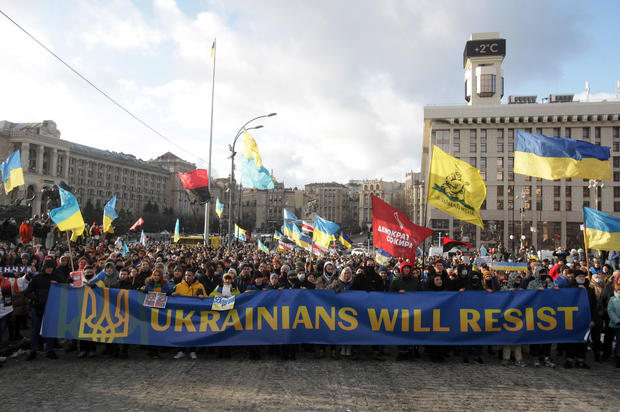What you need to know about the Russia-Ukraine conflict as invasion begins
After Russia spent several weeks building up a sizable military force along its border with Ukraine and in neighboring Belarus, Russian leader Vladimir Putin launched what Ukrainian officials described as a “full-scale invasion” of the country. It marked the start of a grim new chapter in, and a major expansion of an eight-year war in the country’s east that has already claimed thousands of lives.
“Peace on our continent has been shattered,” NATO Secretary-General Jens Stoltenberg said the morning following the invasion. “We now have war in Europe on a scale and of a type we thought belonged to history.”
Adam Berry/Getty Images
Here’s what you need to know about the conflict.
A brief summary of a long history
In the late 1700s, much of Ukraine’s territory became part of the Russian empire under Catherine the Great. Ukraine fought for independence in the early 20th century but lost and became part of the Soviet Union.
“But it was a separate entity from the beginning,” historian Anne Applebaum explained on CBS “Sunday Morning”. “It always had its own language. It always had its own status inside the USSR.”
Under Stalin’s grip in the 1930s, Ukrainians’ farmland and wheat were confiscated and the resulting famine killed an estimated 4 million people.
Ukraine declared its independence after the Soviet Union collapsed in 1991. At the time, a substantial portion of the Soviet nuclear arsenal was housed within Ukraine’s borders, and it agreed to transfer those weapons to Russia.
In recent years, Ukraine’s democratically elected government has grown closer to Western Europe, even as cultural ties to Russia persist, especially in the nation’s east.
Now, as Ukraine’s ambassador to the U.N. told CBS News’ Pamela Falk, Putin’s ambition to “restore the Russian Empire” has moved beyond the annexation of Ukraine’s Crimean Peninsula, which his forces seized in 2014.
Russia has invaded Ukraine before
Russian forces invaded eastern Ukraine in 2014, and Putin claimed the assault was merely a defense of ethnic Russians who live in Ukraine’s eastern Donbas region, who’ve never supported the country’s relatively new, pro-Western government.
But Putin used the invasion to very literally claim part of Ukraine for Russia, unilaterally annexing the Crimean Peninsula. The annexation is not recognized by the international community, but Russia has indisputably controlled the territory since 2014.
Source: CIA World Factbook
Since the annexation, a proxy war has been waged in Donbas between Russian-backed forces and the Ukrainian government. A 2015 peace deal largely ended the major battles, but the fighting has continued, and left more than 14,000 people dead in the process, according to the Ukrainian government.
Earlier this week, Putin unilaterally recognized the independence of two breakaway regions in Donbas — the self-declared “People’s Republics” of Donetsk and Luhansk. The move led to the U.S. and its allies imposing new sanctions on Russia.
What does Putin want?
Russia’s strongman leader speaks often of the ethnic ties between Russia and Ukraine and warns against NATO expanding further eastward toward his borders.
Retired General H.R. McMaster, a former national security adviser, said on “CBS Mornings” following the invasion that Putin was trying to “restore Russia to national greatness.”
“This goes back to the collapse of the Soviet Union in 1991 — what Putin saw as a disaster and what Putin has been driven by since that time and since he took over in the year 2000, you know, 22 years ago,” McMaster said. “He’s been driven by an obsession with restoring Russia to national greatness. And his plan to do that is not to make Russia great, it’s really to drag everybody else down, and you’re seeing, you know, this sustained campaign against, you know, any of the former territories of the Soviet Union and the former Warsaw Pact countries, really, designed to restore Russian influence.”
Weeks before the invasion, Andrea Kendall-Taylor, a former senior intelligence analyst, told CBS News national security contributor Michael Morell she thought there were also “legacy issues at play” for Putin.
“Putin is thinking long term,” she said. “I think he believes that he is the last Russian leader who would be willing to take such risks to reassert Russia’s role as a great power. And so I think for him, the time is, his clock is ticking, time is ticking. … He sees the West as being in decline. He sees the United States is distracted. He sees the trans-Atlantic relationship as under strain and he is leaning in now, I think, to accomplish these very maximalist objectives because I think that he views this as the opportune moment to do that.”
As CBS News’ David Martin reported in January, Putin’s objective is to keep Ukraine — the second-largest country on the continent — from making common cause with the democracies of Europe.
“What motivates Putin,” former NATO Ambassador Ivo Daalder told CBS News, “is a concern about the independence of Ukraine — a worry that a functioning, successful, prosperous democracy in Ukraine poses a direct threat to his rule, because it will give people in Russia the idea that they, too, could enjoy what Ukraine enjoys, and rise up against his autocratic rule.”
Before Russia started its invasion, Putin demanded that NATO rule out admitting any new members from among the former Soviet states — most importantly, Ukraine — and that NATO forces pull back from positions in other countries near Russia. The U.S. and NATO rejected the demand to preclude any new members as a non-starter.
Many analysts believe Putin’s objective is to erode confidence in Ukraine’s government so it can be replaced with a new pro-Russian regime.
Is Ukraine a NATO member?
No. Ukraine has made the quest for NATO membership a cornerstone of its national security policy, and it has refused to back down from that ambition, though even before the current conflict there was no discussion of Ukraine being admitted to the alliance anytime soon.
While many Ukrainians, especially in the country’s east, are pro-Russian, Ukrainians ousted their last pro-Russia president in 2014 and have consistently elected pro-Western politicians since.
Pavlo Gonchar/SOPA Images/LightRocket via Getty Images
“The Ukrainians want to be in NATO,” Ukraine’s U.N. Ambassador Sergiy Kyslytsya told CBS News’ Pamela Falk in early February. “Before 2014, they were already very pro-European Union… At that moment and before 2014, there was no majority. If you polled the nation, we wouldn’t have more than 50% of Ukrainians in favor of the NATO membership. Now, we have very high figures of Ukrainians if they ask if they want to be in NATO. Because now they realize that trying to defend ourselves on our own is not only questionable from the military point of view, but it is also exceptionally expensive economically and financially.”
Why is it America’s problem?
As Ukraine is not a NATO member, the U.S. and most of its European allies have ruled out sending troops into the country to help defend its territory. Instead, they have provided military hardware, cash, and diplomatic support.
The U.S. interest in rebuffing Russia’s aggression is difficult to explain in terms of goods or American lives: Ukraine is not a significant trading partner, and a threat to its territory or sovereignty poses no direct threat to that of the United States.
But the world’s most powerful democracies have struggled for years to keep Putin’s myriad nefarious actions in check — from claiming Crimea, to poisoning dissidents on British soil and blocking U.N. sanctions against the Assad regime in Syria.
As Putin seeks now to deepen Russia’s ties with China, another powerful nation eager to portray the Western model of democracy as past its prime, the U.S. has a clear interest in turning back his latest and boldest effort to drive a wedge between NATO members.
Eleanor Watson, Olivia Gazis, David Martin, Ed O’Keefe, Sara Cook, Margaret Brennan and Christina Ruffini contributed reporting.
For all the latest World News Click Here
For the latest news and updates, follow us on Google News.




